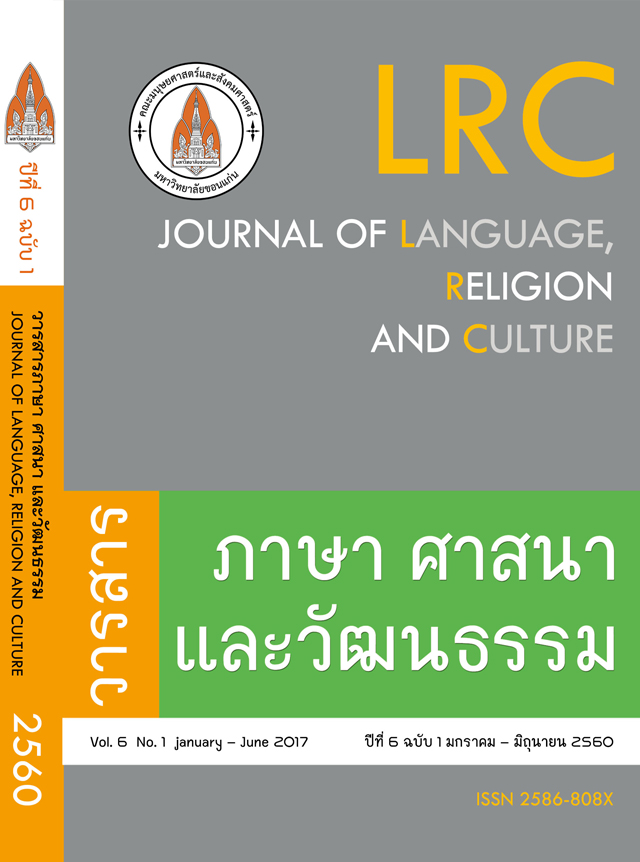วิเคราะห์หลักไตรลักษณ์ในเชิงสุนทรียศาสตร์; The Analysis of the Three Characteristics in Aesthetics Aspect
คำสำคัญ:
ไตรลักษณ์, สุนทรียศาสตร์, three characteristics, aestheticsบทคัดย่อ
วิเคราะห์หลักไตรลักษณ์ในเชิงสุนทรียศาสตร์
บทคัดย่อ
การศึกษาวิจัยนี้ มีวัตถุประสงค์ คือ 1. เพื่อศึกษาหลักไตรลักษณ์ในพระพุทธศาสนา เถรวาท 2. เพื่อศึกษาทฤษฎีทางสุนทรียศาสตร์ และ 3. เพื่อวิเคราะห์หลักของไตรลักษณ์ในเชิงสุนทรียศาสตร์ การวิจัยครั้งนี้เป็นการวิจัยเชิงคุณภาพ ด้วยการศึกษาข้อมูลจากพระไตรปิฎก เอกสารวิชาการทางพระพุทธศาสนา เอกสารวิชาการทางสุนทรียศาสตร์ และงานวิจัยที่เกี่ยวข้อง แล้วนำเสนอผลการวิจัยด้วยวิธีพรรณนาวิเคราะห์
ผลการวิจัยพบว่า แนวคิดหลักไตรลักษณ์ มีความสัมพันธ์กับสิ่งต่างๆ ในการดำรงชีวิตของมนุษย์ โดยมุ่งเน้นด้านอารมณ์ ความรู้สึก ความจริง ความดี และความงาม ตามรูปแบบของพุทธปรัชญาหรืออาจกล่าวได้ว่าเป็นประสบการณ์ทางความงาม
สาระสำคัญของสุนทรียศาสตร์มี 2 นัยยะ คือนัยยะที่เกี่ยวข้องหรือเกี่ยวเนื่องกับสังคมทั่วไป ซึ่งเป็นที่เข้าใจกันตามสภาพสังคม โดยมีลักษณะความสัมพันธ์ เช่น ศิลปะอย่างใดอย่างหนึ่ง จะได้รับการตีค่าว่า สวยงามหรือไม่นั้นต้องประกอบไปด้วยว่า ศิลปะนั้นๆ ได้ส่งเสริมหรือมีวัตถุประสงค์เพื่อสิ่งใด และส่งเสริมให้ผู้รับรู้หรือเสพศิลปะเข้าถึงความจริงหรือไม่
แนวคิดหลักไตรลักษณ์ในเชิงสุนทรียศาสตร์ ว่าด้วยความงามตามหลักพระพุทธศาสนา ต้องเกิดจากการฝึกและปฏิบัติความงามที่เกิดจากศีลเป็นความงามเบื้องต้น ความงามที่เกิดจากสมาธิ เป็นความงามในระดับกลาง และความงามที่เกิดจากปัญญาเป็นความงามในระดับสูง ซึ่งประกอบไปด้วยการอนุเคราะห์ประโยชน์ ความเกื้อกูล และความสุข ส่วนความหลุดพ้นเป็นความงามอย่างสมบูรณ์แบบเป็นนิตย์นิรันดร์
The Analysis of the Three Characteristics in Aesthetics Aspect
Abstract
This study aims at 1) studying Tilakkhaṇa (the three characteristics) in the Theravada, 2) studying the theories of aesthetics, and 3) analyzing Tilakkhaṇa (the three characteristics) in aesthetics aspect. This study is a qualitative research done by collecting the data from Tripitaka, academic papers in relation to Buddhism, academic papers on aesthetics, and relevant research. The analyzed data were descriptively reported.
The results of the study show that Tilakkhaṇa concept is associated with several things in human life by putting an emphasis on emotions, feelings, truth, good deeds, and beauty following the pattern of Buddhist philosophy, or it can be said that the aesthetic experience will help us to feel pleasure.
The main idea in Tilakkhaṇa-oriented aesthetics reveals 2 implications, namely, general society relation that indicates the understanding of society. That is the existence of beauty in arts depends on whether it supports or what its purposes or whether arts support the perceivers in perceiving truth.
The main idea in Tilakkhaṇa-oriented aesthetics in Buddhism need training and practice. The beauty created by moral precept is a primary beauty; the beauty created by meditation is a medium beauty, and the beauty created by wisdom is the highest level of beauty including assistance for benefits and happiness. Finally, disengagement is a result of the beauty of an eternal competition.







